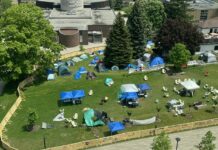Enrolment in the UW Aboriginal studies course, Issues in Contemporary Native Communities, saw a dramatic increase this term of 400 per cent.
Facilitated by St. Paul’s University College, the course is taught by Michael Doxstater from Six Nations Polytechnic. The course increased from the usual 15 students to 80 students.
Luane Lentz, Waterloo Aboriginal Education Centre (WAEC) co-ordinator, believes that the contemporary impact of initiatives such as the Truth and Reconciliation Commission (TRC) have had a major impact on student interest in Aboriginal studies.
“One thing that has come to light in the recent months is the Truth and Reconciliation Commission’s recommendations,” explained Lentz, citing the 94 calls to action released by TRC in 2015. “I think that might be one reason why there has been so much attention.
“There are other issues too … or things that have caught media attention such as missing and murdered indigenous women, idle-no-more …There have been a lot of strides being made and a lot of media attention in positive ways for indigenous people so I think that helps with the interest,” she said.
Lentz hopes the increased interest will propel UW into investigating an Aboriginal studies program. Many universities have ingrained some level of Aboriginal educational components or requirements into their curriculum. However, UW has minimal access to Aboriginal studies, with only a few courses offered in various faculties.
Lakehead University, located in Thunder Bay, requires 18 hours of instruction in indigenous studies per program. The Aboriginal population in the Thunder Bay area is roughly 75,000 people in 49 communities.
Cynthia Wesley-Esquimaux, VP-Provost of Aboriginal Initiatives at Lakehead, explained why it was an important initiative for the campus community. “This is Canada. There has been a lot of history that has been left outside of the knowledge stream.”
Other universities that have similar Aboriginal education requirements include the University of British Columbia and the University of Winnipeg.
When asked why UW doesn’t have any indigenous study requirements, Lentz explained that it is likely due to the demographics of the area.
“Population-wise, [Lakehead and Winnipeg] definitely have a higher population of indigenous people. They likely have more faculty available as well at the universities.”
According to Lentz, the first step to introducing an Aboriginal studies program at UW would be for the school to hire more indigenous staff. “We don’t have as many indigenous faculty as other universities do. So I think trying to recruit and attract indigenous faculty would be a big thing that we need,” she said.
As of right now, WAEC is Waterloo’s main centre for Aboriginal students. Supporting Aboriginal students on campus, providing outreach programs and education to the community are WAEC’s primary initiatives.
Wesley-Esquimaux believes that it is important for schools that don’t already have an Aboriginal studies program, such as UW, to look into implementing one.
“This is 2016. We have been having these conversations for the last 600 years. It has only taken us that long to get to the place where we have to acknowledge and recognize that there are indigenous people in this country …. It is beyond time to ensure that the people of Canada have an understanding and a knowledge of [indigenous] customs, languages, and practices.”






























